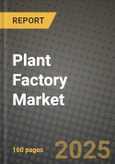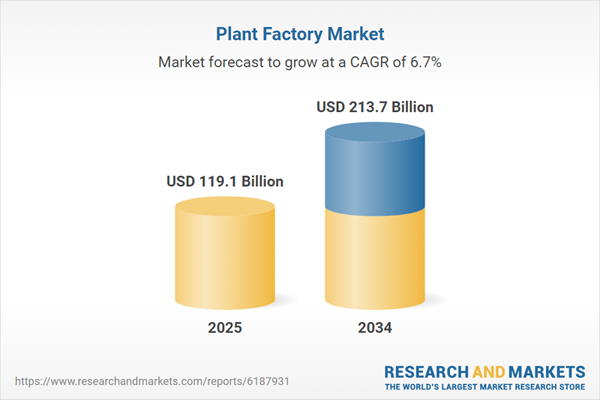Plant Factory Market Overview
The plant factory market is witnessing rapid expansion, driven by the increasing demand for sustainable and high-yield agricultural solutions. Plant factories are advanced indoor farming systems that use hydroponics, aeroponics, and artificial lighting to cultivate crops in controlled environments, ensuring year-round production with minimal land and water usage. With the global population continuing to rise and arable land becoming scarce, plant factories offer a reliable solution to food security challenges while reducing dependence on traditional farming methods. The adoption of vertical farming and smart agricultural technologies is fueling market growth, as urban centers seek locally grown, pesticide-free produce. The integration of automation, artificial intelligence (AI), and IoT-enabled sensors is further enhancing crop productivity and resource efficiency, making plant factories an attractive investment for food producers, retailers, and tech-driven agribusinesses. However, high initial setup costs and energy-intensive operations remain key challenges, requiring ongoing innovation in energy efficiency and cost optimization to ensure long-term profitability.the plant factory market is experiencing significant advancements in energy-efficient growing techniques, automation, and smart monitoring systems. The adoption of LED-based precision lighting is improving plant growth cycles while reducing electricity consumption, making indoor farming more cost-effective. AI-driven climate control systems are being increasingly deployed to optimize temperature, humidity, and nutrient levels, ensuring consistent and high-quality yields. The growing consumer preference for pesticide-free and nutrient-dense produce is driving partnerships between plant factory operators and supermarket chains, enhancing the distribution of fresh greens and herbs. Additionally, the rise of plant-based diets and alternative protein sources is fueling demand for specialized crops such as microgreens, leafy vegetables, and medicinal plants cultivated in plant factories. Governments worldwide are also offering incentives and subsidies for vertical farming and smart agriculture initiatives, encouraging greater adoption of plant factory technology. However, challenges related to power consumption and long-term sustainability continue to be focal points, prompting ongoing research into renewable energy integration and waste reduction strategies.
The plant factory market is expected to witness increased adoption of fully automated farming systems, enhanced AI-driven crop management, and greater investment in energy-efficient infrastructure. The use of blockchain technology for food traceability and supply chain transparency will gain traction, allowing consumers to verify the origin and quality of produce grown in plant factories. The expansion of urban farming initiatives and localized food production will drive demand for compact and modular plant factory systems, making fresh produce more accessible in densely populated areas. Advancements in biotechnology will lead to the development of genetically optimized crops tailored for indoor environments, further increasing yield efficiency. Sustainability will remain a critical focus, with new innovations in solar-powered plant factories, water recycling technologies, and biodegradable growing mediums reducing environmental impact. As consumer preferences shift toward climate-conscious food production, plant factories will play an essential role in the future of agriculture, offering scalable, resource-efficient, and technologically advanced solutions to meet the world’s growing food needs.
Key Insights: Plant Factory Market
- Adoption of AI-Driven Climate and Nutrient Control Systems: The integration of AI-powered monitoring and automation is optimizing plant growth conditions, improving yield consistency, and reducing resource wastage in plant factories.
- Expansion of Vertical Farming for Urban Food Security: The rising demand for locally grown produce is driving the development of vertical plant factories in urban areas, reducing reliance on long-distance food transportation.
- Increased Use of LED Lighting for Energy Efficiency: Advances in LED technology are enhancing photosynthesis efficiency, lowering operational costs, and making plant factories more sustainable and commercially viable.
- Blockchain Integration for Food Transparency and Safety: Blockchain-enabled traceability systems are improving consumer confidence by providing verifiable data on the origin, growth conditions, and quality of plant factory produce.
- Growth in High-Value Crop Cultivation: The demand for premium and medicinal crops, such as microgreens, herbs, and nutraceutical plants, is increasing, encouraging investment in specialized plant factory production.
- Rising Global Demand for Sustainable and Pesticide-Free Food: Consumers are increasingly prioritizing health-conscious and environmentally friendly food choices, fueling demand for plant factory-grown produce.
- Government Initiatives Supporting Controlled Environment Agriculture (CEA): Policymakers are providing subsidies and incentives to promote vertical farming and plant factory technologies to enhance food security and sustainability.
- Technological Advancements in Hydroponics and Aeroponics: Innovations in soilless cultivation methods are increasing yield efficiency while reducing water and land requirements in plant factories.
- Expanding Investment in Agri-Tech and Smart Farming Solutions: Venture capital firms, agribusinesses, and technology companies are investing in plant factories as a high-growth, sustainable alternative to traditional farming.
- High Energy Consumption and Cost of Operations: The energy-intensive nature of plant factories, particularly in lighting and climate control, remains a challenge, requiring continued advancements in energy efficiency and renewable power integration.
Plant Factory Market Segmentation
By Facility Type
- Greenhouse
- Indoor Farms
- Other Facility Types
By Light Type
- Sunlight
- Full Artificial Light
By Growing System
- Non-Soil-Based
- Soil-Based
- Hybrid
By Crop type
- Fruits
- Vegetables
- Flower and Ornamental
- Other Crop Types
Key Companies Analysed
- Applied Materials Inc.
- IHI Hauzer B.V.
- Oerlikon Balzers Coating AG
- Advanced Energy Industries Inc.
- Platit AG
- Semicore Equipment Inc.
- Angstrom Engineering Inc.
- Singulus Technologies AG
- Veeco Instruments Inc.
- AJA International Inc.
- Buhler Alzenau GmbH
- Intevac Inc.
- Impact Coatings AB
- Mustang Vacuum Systems Inc.
- Silfex Inc.
- Denton Vacuum LLC
- CHA Industries Inc.
- Plasma Quest Limited
- Kurt J. Lesker Company
- HEF USA LLC
- Tokyo Electron Limited
- Richter Precision Inc.
- Lam Research Corporation
- KDF Electronics & Vacuum Services Inc.
- Impreglon Canada Ltd.
- Plasma-Therm LLC
- ULVAC Inc.
- voestalpine AG
- ASM International N.V.
- Techmetals Inc.
Plant Factory Market Analytics
The report employs rigorous tools, including Porter’s Five Forces, value chain mapping, and scenario-based modeling, to assess supply-demand dynamics. Cross-sector influences from parent, derived, and substitute markets are evaluated to identify risks and opportunities. Trade and pricing analytics provide an up-to-date view of international flows, including leading exporters, importers, and regional price trends.Macroeconomic indicators, policy frameworks such as carbon pricing and energy security strategies, and evolving consumer behavior are considered in forecasting scenarios. Recent deal flows, partnerships, and technology innovations are incorporated to assess their impact on future market performance.
Plant Factory Market Competitive Intelligence
The competitive landscape is mapped through proprietary frameworks, profiling leading companies with details on business models, product portfolios, financial performance, and strategic initiatives. Key developments such as mergers & acquisitions, technology collaborations, investment inflows, and regional expansions are analyzed for their competitive impact. The report also identifies emerging players and innovative startups contributing to market disruption.Regional insights highlight the most promising investment destinations, regulatory landscapes, and evolving partnerships across energy and industrial corridors.
Countries Covered
- North America - Plant Factory market data and outlook to 2034
- United States
- Canada
- Mexico
- Europe - Plant Factory market data and outlook to 2034
- Germany
- United Kingdom
- France
- Italy
- Spain
- BeNeLux
- Russia
- Sweden
- Asia-Pacific - Plant Factory market data and outlook to 2034
- China
- Japan
- India
- South Korea
- Australia
- Indonesia
- Malaysia
- Vietnam
- Middle East and Africa - Plant Factory market data and outlook to 2034
- Saudi Arabia
- South Africa
- Iran
- UAE
- Egypt
- South and Central America - Plant Factory market data and outlook to 2034
- Brazil
- Argentina
- Chile
- Peru
Research Methodology
This study combines primary inputs from industry experts across the Plant Factory value chain with secondary data from associations, government publications, trade databases, and company disclosures. Proprietary modeling techniques, including data triangulation, statistical correlation, and scenario planning, are applied to deliver reliable market sizing and forecasting.Key Questions Addressed
- What is the current and forecast market size of the Plant Factory industry at global, regional, and country levels?
- Which types, applications, and technologies present the highest growth potential?
- How are supply chains adapting to geopolitical and economic shocks?
- What role do policy frameworks, trade flows, and sustainability targets play in shaping demand?
- Who are the leading players, and how are their strategies evolving in the face of global uncertainty?
- Which regional “hotspots” and customer segments will outpace the market, and what go-to-market and partnership models best support entry and expansion?
- Where are the most investable opportunities - across technology roadmaps, sustainability-linked innovation, and M&A - and what is the best segment to invest over the next 3-5 years?
Your Key Takeaways from the Plant Factory Market Report
- Global Plant Factory market size and growth projections (CAGR), 2024-2034
- Impact of Russia-Ukraine, Israel-Palestine, and Hamas conflicts on Plant Factory trade, costs, and supply chains
- Plant Factory market size, share, and outlook across 5 regions and 27 countries, 2023-2034
- Plant Factory market size, CAGR, and market share of key products, applications, and end-user verticals, 2023-2034
- Short- and long-term Plant Factory market trends, drivers, restraints, and opportunities
- Porter’s Five Forces analysis, technological developments, and Plant Factory supply chain analysis
- Plant Factory trade analysis, Plant Factory market price analysis, and Plant Factory supply/demand dynamics
- Profiles of 5 leading companies - overview, key strategies, financials, and products
- Latest Plant Factory market news and developments
Additional Support
With the purchase of this report, you will receive:- An updated PDF report and an MS Excel data workbook containing all market tables and figures for easy analysis.
- 7-day post-sale analyst support for clarifications and in-scope supplementary data, ensuring the deliverable aligns precisely with your requirements.
- Complimentary report update to incorporate the latest available data and the impact of recent market developments.
This product will be delivered within 1-3 business days.
Table of Contents
Companies Mentioned
- Applied Materials Inc.
- IHI Hauzer B.V.
- Oerlikon Balzers Coating AG
- Advanced Energy Industries Inc.
- Platit AG
- Semicore Equipment Inc.
- Angstrom Engineering Inc.
- Singulus Technologies AG
- Veeco Instruments Inc.
- AJA International Inc.
- Buhler Alzenau GmbH
- Intevac Inc.
- Impact Coatings AB
- Mustang Vacuum Systems Inc.
- Silfex Inc.
- Denton Vacuum LLC
- CHA Industries Inc.
- Plasma Quest Limited
- Kurt J. Lesker Company
- HEF USA LLC
- Tokyo Electron Limited
- Richter Precision Inc.
- Lam Research Corporation
- KDF Electronics & Vacuum Services Inc.
- Impreglon Canada Ltd.
- Plasma-Therm LLC
- ULVAC Inc.
- voestalpine AG
- ASM International N.V.
- Techmetals Inc.
Table Information
| Report Attribute | Details |
|---|---|
| No. of Pages | 160 |
| Published | October 2025 |
| Forecast Period | 2025 - 2034 |
| Estimated Market Value ( USD | $ 119.1 Billion |
| Forecasted Market Value ( USD | $ 213.7 Billion |
| Compound Annual Growth Rate | 6.7% |
| Regions Covered | Global |
| No. of Companies Mentioned | 30 |









